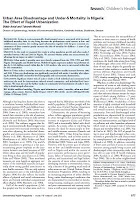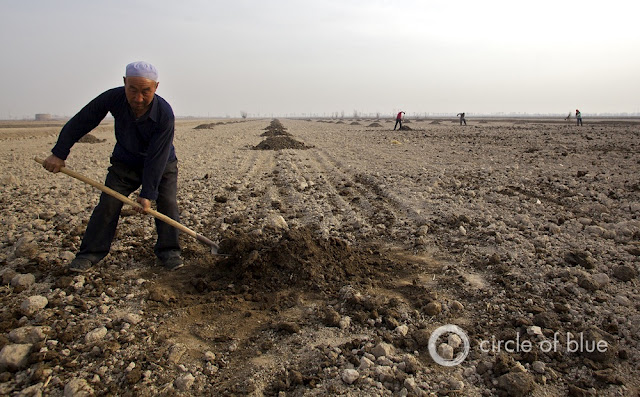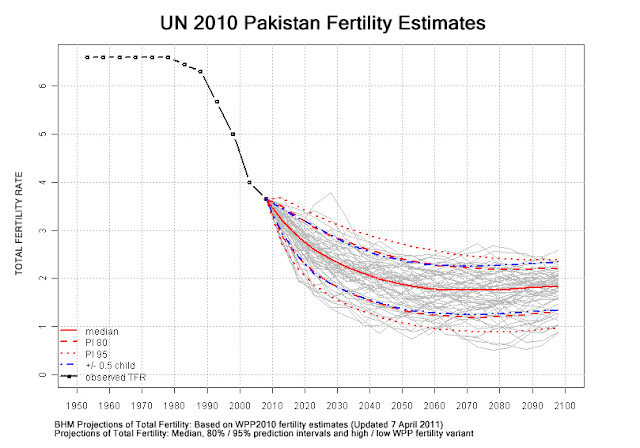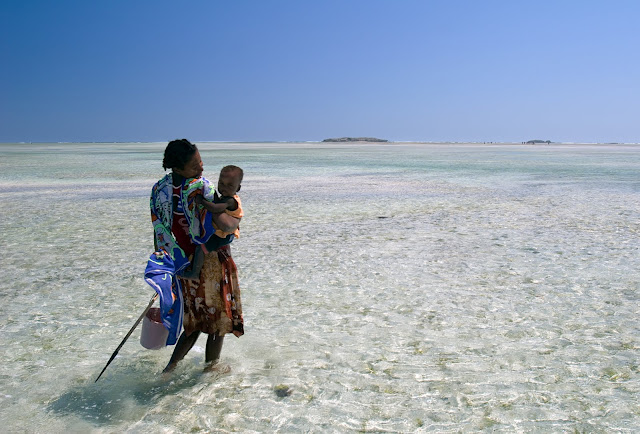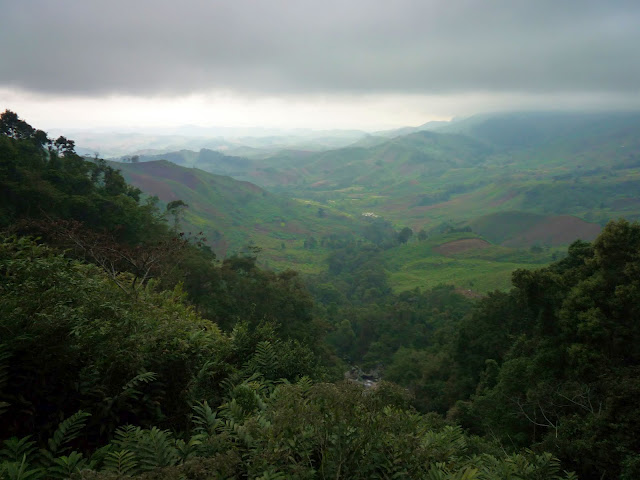Showing posts from category development.
-
The Implications of Urbanization on Food Security and Child Mortality of the Urban Poor
›In the chapter, “Urban Agriculture and Climate Change Adaptation: Ensuring Food Security Through Adaptation,” of the edited volume, Resilient Cities: Cities and Adaptation to Climate Change – Proceedings of the Global Forum 2010, authors Marielle Debbeling and Henk de Zeeuw assess the viability of urban and peri-urban agriculture (UPA) as a method of climate change adaptation for the urban poor. Debbeling and de Zeeuw assert that UPA increases the resilience of cities by diversifying both food supply and income streams for the urban poor; decreasing the negative effects of “heat island effect,” air pollution, and urban flooding; conserving water and utilizing organic waste; and reducing energy use and greenhouse gas emissions. Given the scale and impact of modern urbanization, the authors write that “the integration of UPA into urban development and master plans, urban land use and zoning plans, as well as active maintenance of the protected agricultural zones…is crucial.” In “Urban Area Disadvantage and Under-5 Mortality in Nigeria: The Effect of Rapid Urbanization,” published by Environmental Health Perspectives, authors Diddy Antai and Tahereh Moradi found a significant link between the mortality rate of children under five years of age and a poor and disadvantaged urban environment; such an environment is characterized by poor sanitation, overcrowding, a lack of access to safe water, and high levels of disease-inducing air pollution and hazardous wastes. Although urban living may increase proximity to health care and other social amenities, low- and middle-income countries, such as Nigeria, have overstretched their adaptive capacities and the result is poor health indicators. Antai and Moradi predict that the rapid urbanization of Nigerian cities will bring increased infant mortality, unless individual- and community-based policy interventions are implemented to counter the adverse environmental conditions of deprived areas.
In “Urban Area Disadvantage and Under-5 Mortality in Nigeria: The Effect of Rapid Urbanization,” published by Environmental Health Perspectives, authors Diddy Antai and Tahereh Moradi found a significant link between the mortality rate of children under five years of age and a poor and disadvantaged urban environment; such an environment is characterized by poor sanitation, overcrowding, a lack of access to safe water, and high levels of disease-inducing air pollution and hazardous wastes. Although urban living may increase proximity to health care and other social amenities, low- and middle-income countries, such as Nigeria, have overstretched their adaptive capacities and the result is poor health indicators. Antai and Moradi predict that the rapid urbanization of Nigerian cities will bring increased infant mortality, unless individual- and community-based policy interventions are implemented to counter the adverse environmental conditions of deprived areas. -
Jacob Park, Our World 2.0
Will Expanding “Human Security” Really Improve People’s Lives?
›June 16, 2011 // By Wilson Center StaffThe original version of this article, by Jacob Park, appeared on the UN University’s Our World 2.0.
To those working in the financial markets, the term “securitization” refers to the financial practice of pooling various types of debt, such as residential mortgages, and repackaging them as products like bonds, etc. And you can bet that most of the 2.5 million pages one gets if one searches for this term on the web probably relate to complex financial markets.
Yet the use of the term “security” is not limited to the financial markets and it appears that the United Nations system and the international community seem to be caught up in its own securitization trend. At the April 2011 65th General Assembly of the United Nations, the General Assembly held an informal debate on the human security concept and why it is important to the UN and the international community.
At this meeting, UN Deputy Secretary General Asha-Rose Migiro argued that “in a world where threats could be as sudden and unpredictable as a tsunami or as protracted and unyielding as an oppressive dictatorship, an expanded paradigm of security was needed to encompass the broad range of conditions threatening people’s survival, livelihoods, and dignity.”
In light of the recent triple disaster in Japan and this year’s uprisings in the Arab World, Migiro stated that from “natural disasters and entrenched poverty to outbreaks of conflict and the spread of disease, the dramatic events of recent weeks had underscored the vulnerability of developed and developing countries alike.”
Her views reflect a trend since the 2005 World Summit, where leaders agreed that human security concerned both “freedom from fear” and “freedom from want,” and the definition of human security expanded beyond the traditional military-political paradigm of security to be inclusive of social, energy, and environmental issues.
In fact, a wide range of UN institutions have been active promoting their respective security work; the United Nations Environment Programme (UNEP) in relation to environmental security; the Food and Agricultural Organization in relation to food security; and the United Nations Development Programme/UN Trust Fund for Human Security, among others. (Similarly, the International Energy Agency, founded in response to the 1973/74 oil shocks, today plays an increasingly important role in advising its member countries on energy security.)
Real Solutions or Good Metaphors?
It’s hard to disagree with the expanded definition of security to include a wide range of social, environmental, and human development issues. But toward what ends? What will this diverse focus ultimately lead to?
Perhaps I am being overly pessimistic and need to be more patient for these various security issues to develop as possible policy solutions. However, experience with the term “sustainable development” offers a good illustration of what happens when vague concepts rather than real solutions starts the drive the institutional machinery of global governance.
It seems like at times we’re replacing solutions with metaphors or frames to discuss social, environmental, and human development global concerns. The emerging security narrative feels as if we’re waiting for some military quick fixes; as if there is some special forces unit that can be called upon to get rid of the climate-induced migration problem in the same manner as a special U.S. Navy SEAL team was dispatched to deal with Osama Bin Laden.
Unfortunately, there is a real possibility that these UN programs and initiatives (however worthwhile they may be) on energy security, food security, environmental security, climate security, and human security will attempt to deal with all of these issues at the same time and at the end, risk dealing with none. One thing is certain: more international conferences will be planned on security issues even if it is unclear what real benefits this will provide to the most vulnerable members of the international community, whom this securitization trend is designed to help.
What do you think? Will the securitization of all threats to human life make a difference to “at risk” communities across the globe? Or are we just getting caught up in language and not solutions?
Thoughts? Be sure to follow-up on Our World 2.0 as well.
Jacob Park is an associate professor of business strategy and sustainability at Green Mountain College in Vermont specializing in global environment and business strategy, corporate social responsibility, community-based entrepreneurship, and social innovation.
Photo Credit: “UN Peacekeepers Rescue School Collapse Victims,” courtesy of flickr user United Nations Photo. -
Shall the Religious Inherit the Earth?
›
“The world as a whole is getting more religious,” said Professor of Politics at the University of London Eric Kaufmann, speaking at the Wilson Center for the launch of his latest book, Shall the Religious Inherit the Earth? Due to their consistently higher birthrates, religious fundamentalists may reverse the tide of secularism within the next century, he said. [Video Below]
-
Keith Schneider, Circle of Blue
China’s Other Looming Choke Point: Food Production
›The original version of this article, by Keith Schneider, appeared on Circle of Blue.
Even along the middle reaches of the Yellow River, which irrigates 402,000 hectares (993,000 acres) of farmland north of the Ningxia Hui Autonomous Region’s provincial capital, there is still no mistaking the smell of dry earth and diesel fuel, the abiding scents of a desert province that is also among China’s most efficient grain producers.
Ningxia farmers have relied on the Yellow River since 221 BCE, when Qin Dynasty engineers clawed narrow trenches from the sand, introducing some of the first instances of irrigated agriculture on earth. Despite persistent droughts, in each of the last five years irrigation has made it possible for annual harvests to increase by an average of 100,000 metric tons.
The 2010 harvest of 3.5 million metric tons was nearly double what it was in 1990. The 3.9 million people who live and work on Ningxia’s 1.2 million farms, most no larger than three-quarters of a hectare (1.6 acres), produce the highest yields of rice and corn in the nine-province Yellow River Basin, according to central government crop statistics.
In sum, the farm productivity of this small northern China region – about the same size as West Virginia and located 1,200 kilometers (745 miles) to the west of the Bohai Sea – reflects the major shifts in geography and cultivation practices over the last generation that have made China both self-sufficient in food production and the largest grain grower in the world.
Yet Chinese farm officials here and academic authorities in Beijing are becoming increasingly concerned that China does not have enough water, good land, and energy to sustain its agricultural prowess. As Circle of Blue and the Woodrow Wilson Center’s China Environment Forum have reported in the Choke Point: China series, momentous competing trends – rising energy demand, accelerating modernization, and diminishing freshwater resources – are putting the country’s energy production and security at risk.
The very same trends also threaten China’s farm productivity. Last year, the national farm sector and the coal sector combined used 85 percent of the 599 billion cubic meters (158 trillion gallons) of water used in China.
Continue reading on Circle of Blue.
Keith Schneider is the senior editor of Circle of Blue and was a New York Times national correspondent for over a decade, where he continues to report as a special writer on energy, real estate, business, and technology.
Photo Credit: Used with permission, courtesy of J. Carl Ganter/Circle of Blue. -
Pakistan’s Population Bomb Defused?
›What is going on over at the UN Population Division? In response to The New Security Beat’s post on the UN’s sub-Saharan projections, Ed Carr of USAID recently highlighted what appears to be gross overestimations in the 2010 population revision for Ghana. Yet in the case of Pakistan, the opposite is seemingly at play – the projections appear to wildly (and unrealistically) underestimate population numbers for the coming decades.
The 2008 revision’s mid-variant estimate for Pakistan in 2050 was 335 million people. The new revision projects only about 275 million by that year. Even the new high-variant estimate (314 million) falls below the earlier mid-variant projection. Furthermore, the constant-fertility variant estimate for 2050 has fallen from 450 million to under 380 million.
What gives? Thanks to some helpful staff at the Population Division and Population Action International’s Elizabeth Leahy Madsen (who helped translate the UN’s demographic-ese for this non-specialist), I can only conclude that the UN has decided to hedge its bets that Pakistan’s fertility rates will fall, simply because its South Asian neighbors (and other nations) have followed this trajectory.
If so, I believe this assumption is spurious. As reported in the Wilson Center’s recent book on Pakistan’s population challenges, though Pakistan’s fertility rate is in decline, it is falling at a considerably slower pace than that of its neighbors, and the rate of decrease has slowed considerably over the last decade. The country’s total fertility rate (TFR) today is just under four, considerably above the replacement level rate (2.1).
By many indications, Pakistan’s TFR does not figure to fall quickly anytime soon. Pakistan’s maternal and reproductive health sector is deeply troubled, with family planning services either of poor quality or nonexistent – particularly in rural areas. Many rural women are obliged to travel on average 50 to 100 kilometers to obtain such services. Meanwhile, the status of Pakistani women is dreadful; female literacy is estimated to stand at only 44 percent (some places it as low as 35 percent), while women’s labor participation rates barely approach 20 percent. Not surprisingly, Pakistan’s contraceptive prevalence rate is quite low (30 percent), while its rate of unmet need for family planning is high (25 percent).
With all of Pakistan’s problems, improving access to family planning is simply not a front-burner issue for Islamabad (in fact, as our book notes, demography on the whole is largely neglected in Pakistan), which makes the 2010 revision’s projections all the more questionable.
The UN is expected to release details on the methodology behind its basic assumptions in the coming weeks; here’s hoping for some clarity. (Editor’s note: As Liz Madsen points out, there’s also a white paper on the new probabilistic model to sift through, if you’re prepared for some heavy reading.)
Michael Kugelman is a program associate for the Asia Program at the Woodrow Wilson Center.
Chart Credit: Modification of projections of total fertility based on Bayesian hierarchical model, courtesy of the UN Population Division. -
Watch: Catherine Kyobutungi on Monitoring the Health Needs of Urban Slums
›Addressing the maternal health needs of the nearly 60 percent of urban residents who live in slums or slum-like conditions will be a critical step to improving maternal health indicators of a rapidly urbanizing Kenya, said Catherine Kyobutungi, director of health systems and challenges at the African Population Health Research Center in Nairobi.
“In some respects, [the urban poor] are doing better than rural communities, but in other ways they are behind,” said Kyobtungi. But, she said, there are many unique opportunities to improve maternal health in slums: “With these very high densities, you do have advantages; with very small investments, you can reach many more people.”
Output-based voucher schemes – in which women pay a small fee for a voucher that entitles them to free, high-quality antenatal care, delivery services, and family planning – have been implemented to help poor, urban women access otherwise expensive services. But poor attitudes towards health care workers, transportation barriers, and high rates of crime still prevent some women from taking advantage of these vouchers, said Kyobtungi. -
Helping Hands: An Integrated Approach to Development
›Originally featured in the Wilson Center’s Centerpoint, June 2011.
“At the moment, the agendas of the growing population of people and the environment are too separate. People are thinking about one or the other,” said Sir John Sulston, Nobel laureate and chair of the Institute for Science, Ethics, and Innovation at the University of Manchester, in an interview with the Environmental Change and Security Program (ECSP).
“People argue about, ‘Should we consume less or should we have fewer people?’ The point is it’s both. We need to draw it together. It’s people and their activities.”
Many who research and work on population, health, and environment (PHE) issues are increasingly advocating integrated solutions. Such issues as population growth, natural resource management, and food security, are interrelated challenges that, if addressed concurrently, likely will yield better results and community trust.
With this notion in mind, ECSP launched the five-year HELPS (health, environment, livelihoods, population, and security) project in October 2010. The project focuses on integrated PHE programs and demographic security linkages. HELPS also looks at population’s links to global environmental priorities, media coverage of population, and related issues like gender, youth, and equity.
Funded by USAID’s Office of Population and Reproductive Health through its IDEA (Informing Decision-makers to Act) grant, the HELPS project builds on ECSP’s 14-year history of exploring nontraditional security issues.
Population-Environment Connection
A February event in the HELPS series featured Sir John Sulston, who said dialogue between population and environmental communities has received renewed attention and is reappearing on national agendas.
The Royal Society’s People and the Planet study, which will be completed by early 2012, will “provide policy guidance to decision-makers as far as possible” and aims to facilitate dialogue, he said. The HELPS Project is helping the working group gather evidence of population-environment connections and to identify solutions.
“What we should be aiming to do is to ensure that every individual on the planet can come to enjoy the same high quality of life whilst living within the Earth’s natural limits,” said Sulston. People are happier, healthier, and wealthier than ever before, according to human development indexes. But, Sulston said, 200 million women worldwide have an unmet need for family planning, ecosystems are degraded, biodiversity has decreased, and there are widespread shortages of food and water.
“Many times we tackle different development challenges through single sector programs: health programs, agriculture programs, water programs. Those single sector approaches can make sense,” said ECSP Director Geoff Dabelko on the Wilson Center’s Dialogue television program. “But, of course, poor people are facing all those life and death challenges at once. We have to find ways to help them meet those challenges together in an integrated fashion.”
On the same program, Roger-Mark De Souza, vice president for research and director of the Climate Program for Population Action International, said the drive for integrated development stems from the communities being served, not necessarily from outside aid groups. “We’ve seen that there’s a greater impact because there’s longer sustainability for those efforts that have an integrated approach,” he said. “There’s a greater understanding and a greater appreciation of the value that [PHE] projects bring.”
At an April 7 ECSP event, De Souza said rural communities in developing countries understand that high population growth rates, poor health, and environmental degradation are connected. An integrated approach to development, he said, is a “cost-effective intervention that we can do very easily, that responds to community needs that will have a huge impact that’s felt within a short period of time.”
Proponents of integrated development face significant barriers, but the tide may be turning. To fully harness this momentum, former ECSP Senior Program Associate Gib Clarke argues in his FOCUS brief, “Helping Hands: A Livelihood Approach to Population, Health, and Environment Programs,” that the PHE community must solidify its research base, reach out to new partners, and push for flexible funding and programming. He suggested changing the name PHE to HELP – health, environment, livelihoods, and population. By adding livelihoods, the glue that binds population, health, and the environment, he said, the HELP moniker might broaden its appeal to new donors and practitioners.
Case Study: Madagascar
In Madagascar, a key country for integrated PHE programs, “today’s challenges are even greater than those faced 25 years ago,” said Lisa Gaylord, director of program development at the Wildlife Conservation Society, at a March 28 Wilson Center event. As the country’s political situation has deteriorated since 2009, the United States and other donors pulled most funding, and some PHE programs were forced to discontinue environmental efforts.
But other PHE programs are expanding: Based in southwestern Madagascar, the Blue Ventures program began as an ecotourism outfit, said Program Coordinator Matt Erdman, but has since grown to incorporate marine conservation, family planning, and alternative livelihoods. A major challenge is its rapidly growing population, which threatens the residents’ health and food security, as well as the natural resources on which they depend. More than half the island’s population is younger than 15, and the infant and maternal mortality rates are high, Erdman said.
In response, Blue Ventures set up a family planning program. The program uses a combination of clinics, peer educators, theater presentations, and sporting events, such as soccer tournaments, to spread information about health and family planning. The HELPS project will soon publish a Focus brief on Blue Ventures’ family planning efforts, titled: “To Live with the Sea.”
Erdman said, “If you have good health, and family size is based on quality, families can be smaller and [there will be] less demand for natural resources, leading to a healthier environment.”
Demographic Security
A country’s age structure can pose a challenge, said Jennifer Dabbs Sciubba, the Mellon Environmental Fellow with the Department of International Studies at Rhodes College, at a March 14 Wilson Center event. Countries with a large percentage of people younger than 30 “are [much] more likely to experience civil conflict than states with more mature age structures.”
Tunisia’s recent revolution, Sciubba said, could be understood as a “story about demography.” Countries with transitional age structures, such as India, Brazil, and South Africa, face different security challenges. With a majority of their populations between 15 and 60 years old, more people are contributing to the economy than are taking away, which could bolster these countries economically and politically. Global institutions will have to reform and include these countries, she advised, “or else become irrelevant.”
“Understanding population is critical to our success in being able to prevent conflict, and also managing conflict and crises once we’re involved,” said Kathleen Hicks, Deputy Undersecretary at the Department of Defense (DOD). However, the DOD does not “treat demographics as destiny,” she said, but instead as “one of several key trends, the complex interplay of which may spark or exacerbate future conflicts.”
Demography can also help predict political trends. In 2008, demographer Richard Cincotta predicted that between 2010 and 2020 the states along the northern rim of Africa – Morocco, Algeria, Tunisia, Libya, and Egypt – would each reach a demographically measurable point where the presence of at least one liberal democracy among the five would be probable. Recent months have brought possible first steps to validate that prediction.
Mathew Burrows, counselor at the National Intelligence Council, said Cincotta’s work demonstrates that “the demographic tool is essential” to analysts and policymakers. “There is a real appetite among policymakers” for understanding demography, he said, because it gives them more structure than political science narratives.
Yemen is another example of this trend. In March, tens of thousands of youth-led demonstrators demanded that their president resign. While numerous factors have sparked the “Arab Spring,” one driving force is Yemen’s dire demographic and environmental situation. Some experts say Yemen may be the first country to run out of groundwater. The average Yemeni woman has more than five children, and 45 percent of its population is below age 15. On May 18, Yemeni and international experts discussed these issues at the Wilson Center. Upcoming HELPS events include daylong conferences on Afghanistan and Nigeria.
There are solutions that can break the links between “youth bulges” and insecurity. In a recent video interview discussing the connection between demography and civil conflict, Elizabeth Leahy Madsen, a senior research associate at Population Action International, said, “Policies that have a major impact over time are ensuring education, especially for girls, and providing employment opportunities to the large and growing numbers of young people today.”
Dana Steinberg is the editor of the Wilson Center’s Centerpoint.
Photo Credit: Blue Ventures in Madagascar, courtesy of Garth Cripps. -
Book Launch: ‘Human Population: Its Influence on Biological Diversity’
›Measurements of “human population density and growth can be used to identify changes in the viability of native species, and more directly, in changes in ecological systems or habitat quality,” said Richard Cincotta, consultant at the Environmental Change and Security Program and demographer-in-residence at the Stimson Center, speaking at the book launch of Human Population: Its Influence on Biological Diversity.
Cincotta was joined by coeditor L.J. Gorenflo, associate professor of landscape architecture at Penn State University, and contributing author Christopher Small, research professor at the Lamont-Doherty Earth Observatory and adjunct professor at Columbia University, to discuss the book’s objectives, its diverse and multidisciplinary contributors, and its policy implications. [Video Below]
Establishing a Handbook for the Field
“Human Population: Its Influence on Biological Diversity establishes a handbook for the field,” said Cincotta. While the scientific volume is specifically geared towards researchers and conservation managers rather than policymakers, “there are a few Washington-type policy messages that are useful,” he added.
Human population affects biological diversity in multiple ways. While population density alone can be strongly indicative of the viability of different populations of native species, human activities and their chemical and energetic byproducts can also have a strong impact, even when human population density is low, said Cincotta.
Conserving Biodiversity in Different Settings
“Planned solutions, based on strategic actions, increasingly are essential,” said Gorenflo, a professor at Penn State University. “The days of letting nature take care itself are probably gone.” Gorenflo presented results from the two chapters he worked on: “Human Demography and Conservation in the Apache Highlands Ecoregion, U.S.-Mexico Borderlands” and “Exploring the Association Between People and Deforestation in Madagascar.”
“Population density seems to be a reasonably good indicator of biodiversity loss,” said Gorenflo. Data from the Apache Highland Ecoregion (a 12 million-hectare area located along the U.S.-Mexico border) indicate that biodiversity tends to drop off at population densities of more than 10 people per square kilometer. Conservation efforts in areas within the ecoregion that are at, or close to, this density threshold will likely encounter challenges to maintaining biodiversity, he said.
Human mobility is a major consideration, said Gorenflo: “Whereas high fertility can create population growth over generations, high mobility can create population growth in a matter of months or years.” In the Apache Highlands, for example, the 40 percent increase in population between 1990 and 2000 was largely caused by migration into U.S. cities in the region.
In Madagascar, Gorenflo and colleagues examined whether population growth and poverty were systematically driving deforestation and loss of biodiversity. Using data from the 1990s, they found that higher population density only slightly raises rates of deforestation and large increases in income only modestly decrease deforestation.
Not surprisingly, they found that the likelihood of deforestation decreased dramatically in protected areas. In addition, proximity to roads or footpaths was associated with significantly higher rates of deforestation. “Roads, footpaths, and protected areas are all policy decisions,” Gorenflo pointed out. “So when bilateral or multilateral organizations decide to invest in development in a place like Madagascar, they can look at these sorts of investments as being important.”
While there are some similarities to be drawn between regions’ experience with population and biodiversity, said Gorenflo, “every locality likely has a slightly different story; you need to do context-specific studies to get a real handle on what is going on.”
The Human Habitat
In his chapter, “The Human Habitat,” Christopher Small of the Lamont-Doherty Earth Observatory said his goal was “to set the stage for some of the more detailed studies by taking a look at the global distribution of human population.”
Using census data and satellite-derived maps of night lights to serve as a “proxy for development,” Small found that “people are everywhere, but they are not evenly distributed.”
At least half the world’s population lives on less than three percent of the inhabitable land, and most people live at densities between 100 and 1000 people per square kilometer. At both local and global scales, population density and city size are dominated by extremes: There are large numbers of small groups of people, and small numbers of large groups of people, he said.
“The environments where people live are more strongly correlated with features of the landscape than they are with climatic parameters,” said Small. While humans have effectively adapted to a range of climates, the majority of people tend to cluster close to rivers, at low elevations, and close to coastlines. Although it was once thought that three-quarters of the world’s population lived in coastal regions, Small’s results show that the actual number is close to half of these previous assumptions.
Understanding the spatial and environmental distribution of population and managing population growth may therefore help minimize negative impacts on specific habitats and biomes, said Small.
Image Credit: “View from a Madagascar Train,” courtesy of flickr user cr01.



